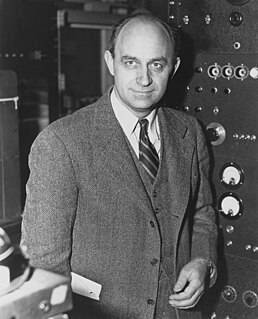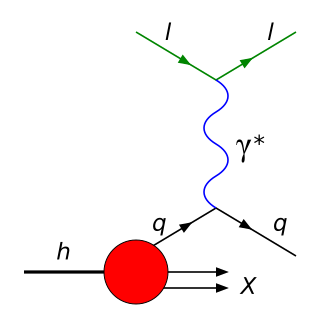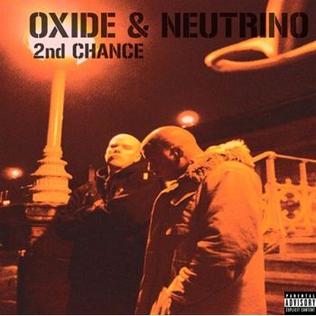
In nuclear physics, beta decay (β-decay) is a type of radioactive decay in which a beta ray is emitted from an atomic nucleus. For example, beta decay of a neutron transforms it into a proton by the emission of an electron accompanied by an antineutrino, or conversely a proton is converted into a neutron by the emission of a positron with a neutrino, thus changing the nuclide type. Neither the beta particle nor its associated (anti-)neutrino exist within the nucleus prior to beta decay, but are created in the decay process. By this process, unstable atoms obtain a more stable ratio of protons to neutrons. The probability of a nuclide decaying due to beta and other forms of decay is determined by its nuclear binding energy. The binding energies of all existing nuclides form what is called the nuclear band or valley of stability. For either electron or positron emission to be energetically possible, the energy release or Q value must be positive.

In particle physics, an elementary particle or fundamental particle is a subatomic particle with no sub structure, thus not composed of other particles. Particles currently thought to be elementary include the fundamental fermions, which generally are "matter particles" and "antimatter particles", as well as the fundamental bosons, which generally are "force particles" that mediate interactions among fermions. A particle containing two or more elementary particles is a composite particle.

In particle physics, a fermion is a particle that follows Fermi–Dirac statistics. These particles obey the Pauli exclusion principle. Fermions include all quarks and leptons, as well as all composite particles made of an odd number of these, such as all baryons and many atoms and nuclei. Fermions differ from bosons, which obey Bose–Einstein statistics.

The muon is an elementary particle similar to the electron, with an electric charge of −1 e and a spin of 1/2, but with a much greater mass. It is classified as a lepton. As is the case with other leptons, the muon is not believed to have any sub-structure—that is, it is not thought to be composed of any simpler particles.

A neutrino is a fermion that interacts only via the weak subatomic force and gravity. The neutrino is so named because it is electrically neutral and because its rest mass is so small (-ino) that it was long thought to be zero. The mass of the neutrino is much smaller than that of the other known elementary particles. The weak force has a very short range, the gravitational interaction is extremely weak, and neutrinos, as leptons, do not participate in the strong interaction. Thus, neutrinos typically pass through normal matter unimpeded and undetected.

In particle physics, a pion is any of three subatomic particles:
π0
,
π+
, and
π−
. Each pion consists of a quark and an antiquark and is therefore a meson. Pions are the lightest mesons and, more generally, the lightest hadrons. They are unstable, with the charged pions
π+
and
π−
decaying with a mean lifetime of 26.033 nanoseconds, and the neutral pion
π0
decaying with a much shorter lifetime of 8.4×10−17 seconds. Charged pions most often decay into muons and muon neutrinos, while neutral pions generally decay into gamma rays.

In particle physics, a lepton is an elementary particle of half-integer spin that does not undergo strong interactions. Two main classes of leptons exist: charged leptons, and neutral leptons. Charged leptons can combine with other particles to form various composite particles such as atoms and positronium, while neutrinos rarely interact with anything, and are consequently rarely observed. The best known of all leptons is the electron.
The W and Z bosons are together known as the weak or more generally as the intermediate vector bosons. These elementary particles mediate the weak interaction; the respective symbols are
W+
,
W−
, and
Z
. The W bosons have either a positive or negative electric charge of 1 elementary charge and are each other's antiparticles. The Z boson is electrically neutral and is its own antiparticle. The three particles have a spin of 1. The W bosons have a magnetic moment, but the Z has none. All three of these particles are very short-lived, with a half-life of about 3×10−25 s. Their experimental discovery was a triumph for what is now known as the Standard Model of particle physics.
Jogesh C. Pati is an Indian American theoretical physicist at the SLAC National Accelerator Laboratory.

Deep inelastic scattering is the name given to a process used to probe the insides of hadrons, using electrons, muons and neutrinos. It provided the first convincing evidence of the reality of quarks, which up until that point had been considered by many to be a purely mathematical phenomenon. It is a relatively new process, first attempted in the 1960s and 1970s. It is an extension of Rutherford scattering to much higher energies of the scattering particle and thus to much finer resolution of the components of the nuclei.
In particle physics, a generation or family is a division of the elementary particles. Between generations, particles differ by their flavour quantum number and mass, but their interactions are identical.
Sterile neutrinos are hypothetical particles that interact only via gravity and do not interact via any of the fundamental interactions of the Standard Model. The term sterile neutrino is used to distinguish them from the known active neutrinos in the Standard Model, which are charged under the weak interaction.
Leptoquarks are hypothetical particles that carry information between quarks and leptons of a given generation that allow quarks and leptons to interact. They are color-triplet bosons that carry both lepton and baryon numbers. They are encountered in various extensions of the Standard Model, such as technicolor theories or GUTs based on Pati–Salam model, SU(5) or E6, etc. Their quantum numbers like spin, (fractional) electric charge and weak isospin vary among theories.
The Koide formula is an unexplained empirical equation discovered by Yoshio Koide in 1981. In its original form, it relates the masses of the three charged leptons; later authors have extended the relation to neutrinos, quarks, and other families of particles.

Execute is the debut album of So Solid Crew members Oxide & Neutrino, released on 28 May 2001. It features the Casualty sampling number 1 single "Bound 4 Da Reload (Casualty)" and the Prodigy cover "No Good 4 Me". The song "Devil's Nightmare" was also featured on the Lara Croft: Tomb Raider soundtrack.

2 Stepz Ahead is the second album by Oxide & Neutrino, released on 30 September 2002. The album features two top 20 singles and peaked at #28 on the UK albums chart. The song "Shoot 2 Kill" was prominently featured in the film Ali G Indahouse and also appeared on the soundtrack.

In classical physics and general chemistry, matter is any substance that has mass and takes up space by having volume. All everyday objects that can be touched are ultimately composed of atoms, which are made up of interacting subatomic particles, and in everyday as well as scientific usage, "matter" generally includes atoms and anything made up of them, and any particles that act as if they have both rest mass and volume. However it does not include massless particles such as photons, or other energy phenomena or waves such as light or sound. Matter exists in various states. These include classical everyday phases such as solid, liquid, and gas – for example water exists as ice, liquid water, and gaseous steam – but other states are possible, including plasma, Bose–Einstein condensates, fermionic condensates, and quark–gluon plasma.












